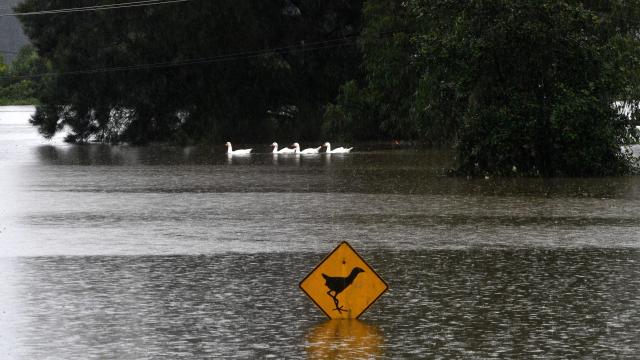Parts of Australia are underwater. The country has seen three feet of rain in just five days, constituting a once-in-a-century event. The waters have wreaked havoc on communities, forced 18,000 people to evacuate, washed away homes, and destroyed infrastructure. On top of all that, they’re also putting wildlife at risk, too.
All kinds of animals have gotten swept up in the floodwaters. One viral video from Friday shows a kangaroo escaping the deluge. But much of Australia’s wildlife isn’t faring as well.
“We’ve lost a lot of animals this weekend,” Nat Blatchford of the New South Wales-based animal rescue service Wildlife in Need of Care, told the Guardian, noting that some kangaroos had perished, as had many birds that became waterlogged in the rain.
Experts are also concerned for animals that live underground, like quolls and echidnas. Since these animals dwell in tunnels they dig in the soil, they can easily get trapped inside their homes by floodwaters. Blatchford told the Guardian that her organisation has already seen this happen to wombats, and another expert told the outlet that bandicoots have also been affected.
The chaos is hardly limited to land. Rescue workers have also found several hawksbill turtles washed ashore by massive storm surge in the ocean, as well as hundreds of baby loggerhead tortoises, which are an endangered species.
Not all the animals threatened by the floods are quite so charismatic. Australians have also captured photos of spiders and snakes swarming into their neighbourhoods and homes, looking to escape the rising waters. That’s a nightmarish scenario itself, and it also indicates that many others are likely succumbing to the floods. That’s bad news since both spiders and snakes play vital roles regulating the food chains of Australian ecosystems. But also, coming home to a flooded house full of snakes is an absolute nightmare in itself. New South Wales authorities are warning residents returning home to keep an eye out for snakes as well as structural damage once it’s safe for evacuees to return home in what is easily some of the most Australian advice imaginable.
The timing comes after the continent’s wildlife endured a brutal year in 2020 as bushfires ravaged the countryside. An estimated 3 billion animals were killed or displaced in the deadly blazes. The floods also come just three weeks after national officials announced 12 species have recently gone extinct in the country, including the first reptile known to have been lost since Europe colonised Australia in the 1700s. It seems Australian wildlife can’t catch a damn break, and it’s an absolute bummer.
Thankfully, there are steps world leaders — including Australian ones — can take to protect the biodiversity we have left. That includes overhauling food systems and restoring ecosystems, as well as enacting serious climate policy which could help ensure these weather disasters don’t get even worse. Because the last thing we need is more snakes, dead or alive, ending up in people’s homes.
